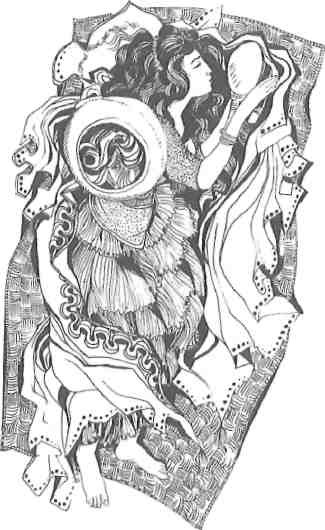It lies in the shadow of Youhtas (Mount Juktas) a mountain in the shape of a reclining man which is said to be the Great God Zeus asleep. Set on the slope of a hill surrounded by vineyards, Archanes is celebrated for its heady wine. Ten years ago it also became famous in the more sober world of scholarship when a Minoan Palace was discovered in the middle of the village. On an adjacent hill called Fourni, archaeologists found, at the same time,a cemetery which has proved to be the most important in the prehistoric Aegean.

This necropolis, which lies under olive trees and amid grapevines, has yielded five tholos tombs and many other above-ground and subterranean burial chambers with paved areas and courtyards. These structures were in very good condition; some were pre-served to a height of three metres.
The Fourni necropolis is, literally, without parallel not only in Crete and the Aegean islands but in the known prehistory of the Greek mainland. This is largely because it was used for burial and worship of the dead for more than a thousand years (ca. 2300-1200 BC). The cemetery’s importance is indicated by the discovery of many buildings that were inhabited by the living, that is to say by guards, priests and workmen occupied in crafts connected with the dead. Excavation has proved that the cemetery was used not only for nobles but for common people too, as collective graves have been uncovered as well.
The artifacts found in the tombs, the property of the dead, are the most important to have come to light in a Minoan cemetery to date. For this reason they have been given a special display in the Museum at Iraklion. Among them are numerous gold objects, rings and necklaces; hundreds of important seals, mostly made of semi-precious stones; astonishing ivories carved with a variety of scenes; a , great number of copper, stone and clay vases; copper ornaments; and stone, clay and copper figurines.
The woman lay on her back, but turned slightly to her left so that she faced towards Mount Youhta… This terrible image of death struck the excavators even more when they realized that her now bare skull had once been adorned with a magnificent crown.
The year 1965, when the first unrobbed Mycenean tholos tomb in Crete was uncovered, was, therefore, a particularly important year in the excavations. In July of this year, this success was repeated when another untouched tholos tomb was opened to reveal still other sensational finds.
The existence of this tholos tomb had, in fact, been known for several years. Part of the upper dome of the tholos was visible in a ditch beside a wall built by farmers to separate their lands. The archaeologists had to wait anxious¬ly for the land to be expropriated before they could excavate this tomb which seemed so promising.
On the first day of the excavations it became clear that it was a small tomb for only one burial and that it had been constructed about 1300-1280 BC when the Myceneans controlled all of Crete. On the following day the archaeologists’ wildest hopes were fulfilled as one rich find after another came to light.
The tomb was that of a mature woman who certainly came of a rich and royal lineage. The first object that had been placed on the floor of the tomb was a clay pyxis, or box, beautifully decorated, in which had been placed a copper razor and a necklace of gold beads in various shapes. It seems that the wooden stretcher which carried the body had been placed on top of this box. The woman lay on her back, but was turned slightly to her left so that she faced towards Mount Youhta. She held in one hand a mirror — a copper disc. This terrible image of death struck the excavators even more when they realized that her bare skull, now penetrated by the roots of trees, had been adorned with a crown so magnificent in quality and so extraordinary in preservation that not even the royal tombs of Mycenae have yielded any-thing to equal it. Double rows of beads, each shaped like an argonaut (the paper nautilus), with similar ones of cut glass, surrounded the upper part of her head. Her chest was covered with many elaborate necklaces made of gold beads, yellow faience and blue glass. With these was found one minute seal-stone of green jasper. It is certain that the woman had long hair for two gold hair fasteners were found at the level of her waist where her ringlets must have reached. She must have been wearing a long gown and had a veil over her shoulders, since a row of gold beads in the shape of rosettes was found in positions which indicated that they had been sewn on to the material.
That night in a dream one of the students on the excavation saw a princess wearing all the jewels he had been wearily recording that day. ‘She was a beautiful woman,’ he said, ‘and she had green eyes.’
The excavations at the Archanes necropolis during this past summer provided much new information about the burial customs and the wealth of Crete in the thirteenth century B.C. The world also came into the possession of a collection of jewellery worked with a delicacy that the most famous jewellers of today might envy. But who can say if the most significant fact of all is not that of one young man’s vision of a princess with green eyes?







